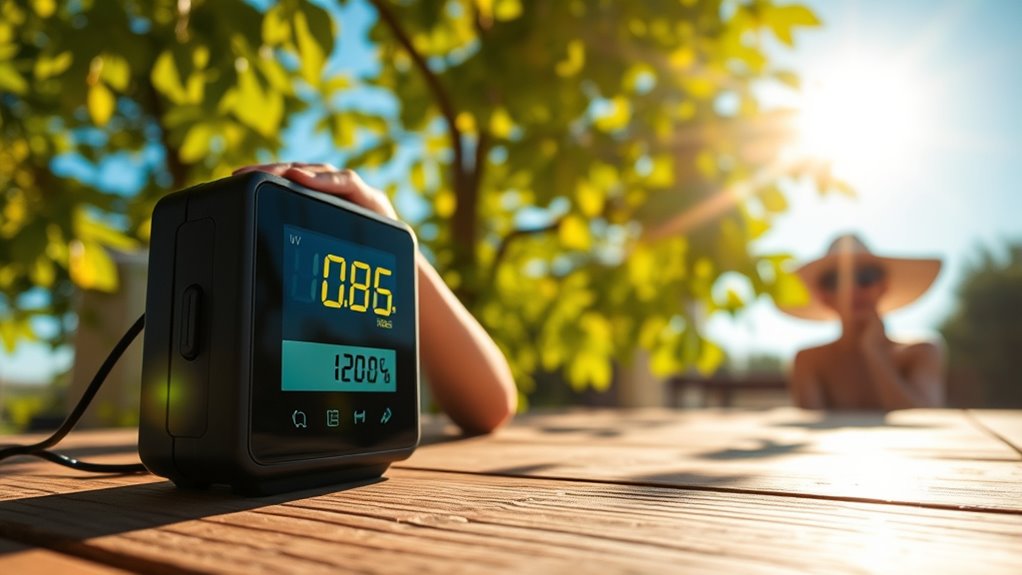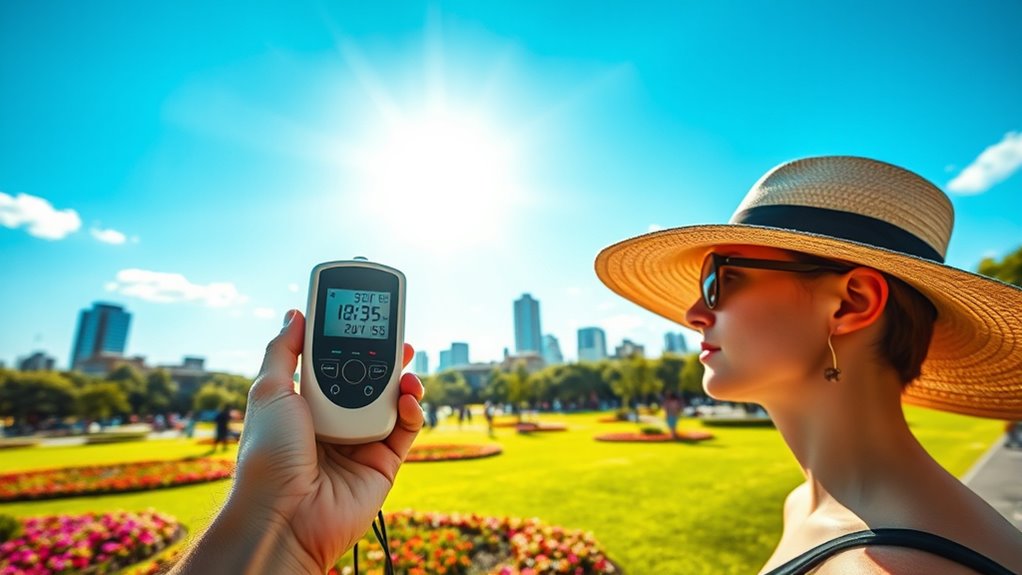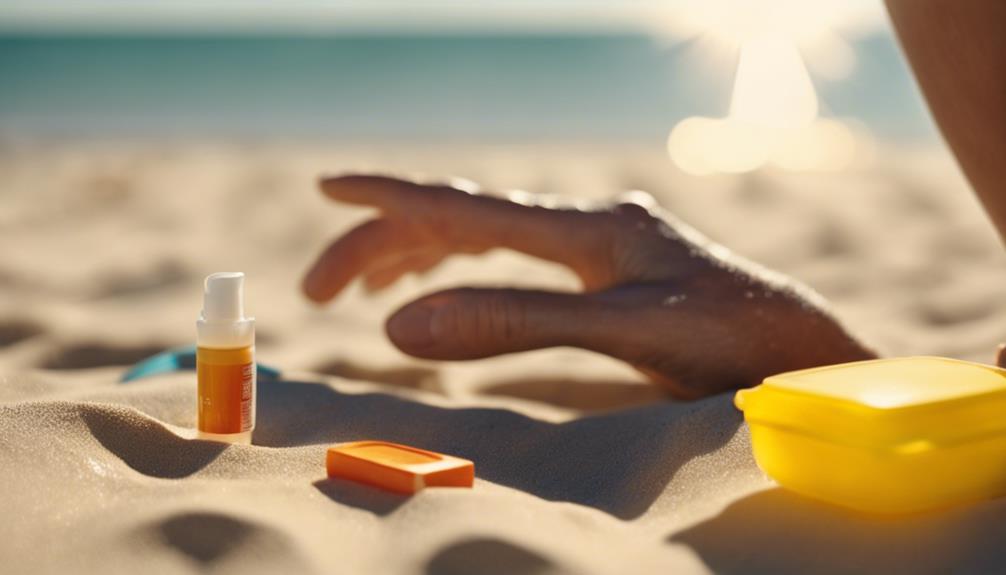The UV index measures how much UV radiation reaches your skin, using specialized tools like radiometers and spectroradiometers that detect UV light levels at different wavelengths. It considers factors like the sun’s angle, clouds, ozone, and surface reflection to give a standard number indicating risk. Understanding this helps you decide when to protect yourself from sun damage, and if you stay curious, you’ll discover even more about how it impacts your health.
Key Takeaways
- The UV index is calculated using measurements from UV radiometers and spectroradiometers that analyze UV light intensity at specific wavelengths.
- Environmental factors like sun angle, cloud cover, ozone, and surface reflectivity are integrated into UV index calculations for accuracy.
- Real-time UV data collection ensures reliable forecasts, helping individuals assess the risk of skin damage from sun exposure.
- A higher UV index indicates increased potential for skin harm, guiding protective actions like seeking shade and wearing protective clothing.
- Monitoring UV levels supports public health policies and campaigns promoting safe sun practices to prevent skin damage and promote skin health.

Have you ever wondered how the UV index is determined and why it’s important for your skin’s health? Understanding the way UV measurement techniques work can help you better grasp how the UV index provides essential information about sun exposure. Essentially, scientists use specialized instruments called UV radiometers and spectroradiometers to measure the amount of ultraviolet radiation reaching the Earth’s surface. These devices detect the intensity of UV light at different wavelengths, allowing experts to calculate an accurate UV index value. This process accounts for factors like the sun’s angle, cloud cover, ozone levels, and surface reflectivity, all of which influence the amount of UV radiation you’re exposed to. The resulting UV index is a standardized number that indicates the strength of UV radiation at a specific time and place, making it easier for you to understand the potential risk of skin damage. Automation in data collection also plays a role in providing real-time UV measurements, ensuring that forecasts are timely and accurate.
Knowing how the UV index is measured is critical because it directly impacts your skin damage prevention strategies. When the UV index is high, the risk of skin harm increases, and you need to take extra precautions. Conversely, a low UV index suggests that UV radiation is less intense, so your exposure may be less dangerous. By paying attention to the UV index forecast, you can make smarter decisions about outdoor activities, such as limiting your time in the sun, seeking shade, or wearing protective clothing and sunscreen. This proactive approach helps you reduce the risk of sunburn, premature aging, and other skin-related issues caused by excessive UV exposure.
The importance of these measurement techniques extends beyond individual habits—they also inform public health policies and sun safety campaigns. Accurate UV measurement ensures that the UV index reflects real-time conditions, empowering you to act accordingly. When the UV index rises, authorities often recommend protective measures to prevent skin damage, and understanding how these levels are determined helps you see the science behind those recommendations. By integrating UV measurement techniques into daily life, you gain a valuable tool for skin damage prevention. It’s not just about avoiding burns; it’s about caring for your skin in the long term, safeguarding your health, and maintaining a youthful appearance. Staying informed about UV levels, and understanding how they are measured, allows you to strike a balance between enjoying the sun and protecting your skin from harm.
Frequently Asked Questions
How Does Altitude Affect UV Index Readings?
Altitude impacts UV index readings by increasing measurement variations as you go higher. When you’re at higher elevations, the atmosphere’s thinner, allowing more UV rays to reach your skin. This means the UV index can be markedly higher than at sea level. So, you should be extra cautious in mountainous areas, as the altitude impact means UV exposure is more intense and requires stronger sun protection to prevent damage.
Can UV Index Measurements Vary During Different Times of the Day?
Yes, UV index measurements can vary during different times of the day. You’ll notice a clear pattern of time fluctuation and daily variation, with the UV index rising as the sun climbs higher and falling as it dips lower. Mornings and late afternoons tend to have lower readings, while midday peaks deliver the strongest UV exposure. Stay mindful of these changes to protect your skin and eyes effectively throughout the day.
How Accurate Are Personal UV Monitoring Devices?
Personal UV monitoring devices can be quite accurate, but their sensor accuracy depends on proper calibration and quality. You should regularly calibrate your device according to the manufacturer’s instructions, as calibration challenges can impact readings. Keep in mind that environmental factors, like shadows or reflective surfaces, may also affect accuracy. When used correctly and maintained properly, these devices provide reliable UV exposure information to help you protect your skin.
What Are the Long-Term Health Effects of UV Exposure?
Prolonged UV exposure can cause serious long-term health effects, including skin damage like premature aging and increased risk of skin cancer. It also harms your eye health, raising chances of cataracts and other eye problems. To protect yourself, wear broad-spectrum sunscreen, sunglasses, and protective clothing, especially during peak sunlight hours. Regularly check your UV exposure levels and avoid overexposure to reduce these risks and keep your skin and eyes healthier over time.
How Do Weather Conditions Influence UV Index Levels?
Weather conditions greatly influence UV index levels. When there’s cloud cover, it blocks some UV rays, reducing the UV index, so you might not feel as exposed. However, on clear days, UV levels can soar, increasing your risk. Air pollution can also either scatter or absorb UV rays, sometimes lowering UV exposure. Always check the daily UV forecast, especially during high pollution or overcast weather, to protect your skin effectively.
Conclusion
Now that you understand how the UV index is measured and why it’s essential, you can better protect yourself from harmful rays. Think of it as your personal shield, like a knight’s armor in a modern-day quest for sun safety. Keep an eye on the UV index forecast, and don’t forget your sunscreen, sunglasses, and hat. By staying vigilant, you’ll avoid turning into a lobster and enjoy your sunny days just like a carefree pirate on the high seas.









